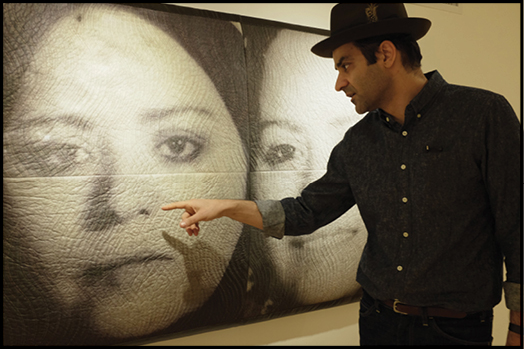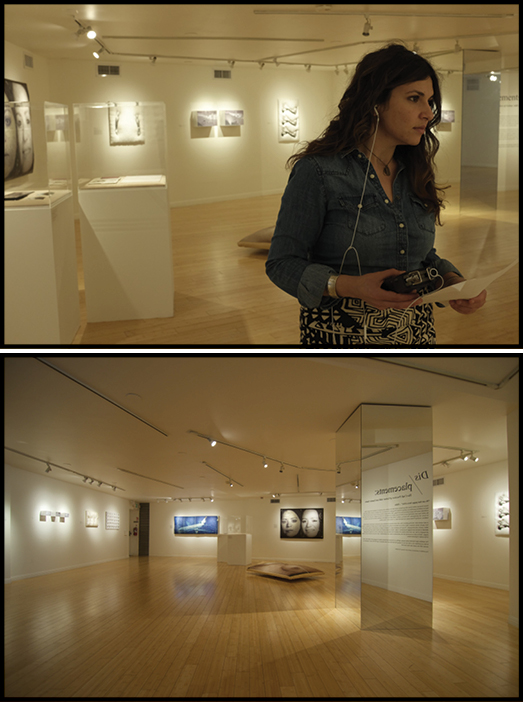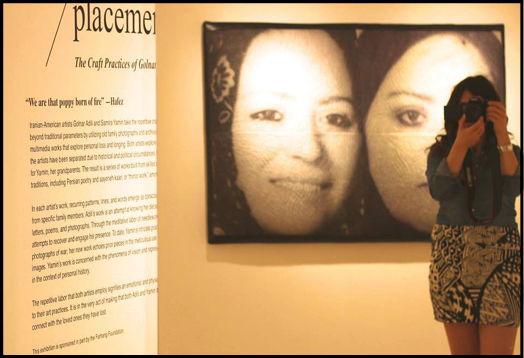
I was recently invited to The Craft & Folk Art Museum (CAFAM) by Arash Saedinia for a walk through in the exhibit Displacements, which he curated, that features Iranian-American artists Golnar Adili and Samira Yamin. The works, created especially for this exhibit, with the intricate craft arts of paper cutting and handstiching of family archives, give audiences a sense of a history filled with questions unanswered and a yearning for connection.
When Saedinia first saw the work of both artists before bringing them together for the exhibit, he was struck by affinities between their practices. Samira at the time was working on the west coast, and Golnar on the east coast. 
Photo Credit: Masa Zokaei
Adili was out of the country when Hurricane Sandy hit, and her friends attempted to preserve what is in the flooded basement of her studio. She was then forced her to go through her father’s archives, something she found difficult to do before because of her father passing away at a young age.
For Yamin, when she heard her grandmother was sick in Iran, she decided to go back there to see her before she passed away. While she was there, she had an opportunity to look through photographs of her grandparents, including her grandfather whom she didn’t know well.
Yamin’s video installation “Scotoma,” catches my eye first. Named after the distortion of vision associated with migraine (which Yamin experiences) Saedinia says as you view the work, “suddenly there will be this warping. And this animation is slowly mimicking scotoma, so this is both an evocation of neurological condition that she has and also a photograph of her grandfather and her grandmother… about exile and lost and an attempt to recapture those that were lost.”
The animation is of a sequence of cuts Yamin has made in the negatives of the photos, a practice she was doing previously with TIME magazines using Islamic geometries.
Another work that stands out in the exhibit was one that featured Adili’s mother’s passport photos which show her mother when she went back to Iran and in when she returned three years later. The photos show the stark contrast of mood and illustrate a change: a colorful headscarf and, later, a dark headscarf accompanied by a serious expression.
The embroideries by Adili are all done by hand and the images on the work are actually like the security mark used on the passport. Saedinia explains the significance:
“It’s metaphorical. These documents are an important part of ourselves; in this case they allow us or don’t allow us passage. She’s playing with the material and the language and the aesthetics of the documents itself in the artwork…”

Photo Credit: Arash Saedinia
With a city home to several hundred thousand Iranians, and a neighborhood in the center called Tehrangeles, it’s not that much of a surprise to hear that Displacements has been met with great interest. The show opened alongside shows of work by Timothy Washington and Shirley Familian. The launch event led to the largest turnout for a CAFAM opening in recent memory. Saedinia feels there is more that institutions can do for this community.
“The exhibition was not only for Iranian or Iranian Americans; the idea [was] to exhibit compelling work by Iranian artists for which there is a huge need, and at the same time give people a sense of these experiences beyond just the community itself.”
“This country and Iran have experienced a close and fractious history…this is a space for the exploration of a lot of those things.”
Saedinia says he was just the facilitator and had no say in the direction of their works, but that they came together very organically. He did have some hopes though, that he says he has witnessed happening as people have come to see the exhibit since it opened in January.
“My hope was [that] a teenage Iranian-American who has never been to Iran can see compelling work by Iranian artists, and they see something that speaks to them on a number of levels, and they say, ‘Yeah we matter, and our stories matter—and it’s here in a museum.’
“Then the parents themselves see their experiences articulated in a way that is moving. I know that is the case because so many Iranians have experienced displacement.”
DISPLACEMENTS: THE CRAFT PRACTICES OF GOLNAR ADILI AND SAMIRA YAMIN, curated by Arash Saedinia, runs until April 27, 2014. Visit www.cafam.org for museum information.

Photo Credit: Masa Zokaei

